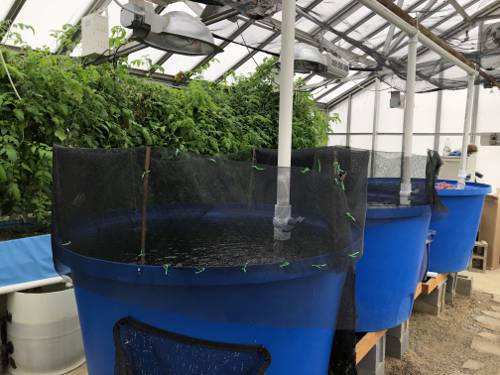
FAQ About Indoor Aquaponics for Integrated Systems

What is indoor aquaponics?
Indoor aquaponics is the practice of integrating aquaculture (raising fish) with hydroponics (growing plants without soil) in an indoor environment. This sustainable gardening system utilizes fish waste as a natural fertilizer for plants, and plants help to purify the water for fish. This mutually beneficial relationship creates a closed-loop system that can be ideal for both homes and educational settings.

How does an integrated indoor aquaponic system work?
In an integrated indoor aquaponic system, fish are raised in tanks and their waste, rich in ammonia, is converted by beneficial bacteria into nitrates, which are nutrients for plants. Plants are grown in a soilless medium, usually in grow beds placed above the fish tanks. As water circulates through the system, plants absorb the nutrients, effectively filtering the water which is then cycled back to the fish tanks. This continuous loop ensures a balanced ecosystem for both plant and aquatic life.

What are the benefits of indoor aquaponics?
Indoor aquaponics offers numerous benefits, including water conservation, as the system uses up to 90% less water than traditional gardening. It also provides a steady supply of fresh, organic produce and fish, reduces the need for chemical fertilizers, and minimizes waste through nutrient recycling. Moreover, indoor setups are not subject to external weather conditions, allowing for year-round agriculture.

What are the best plants to grow in an indoor aquaponic system?
The best plants for indoor aquaponic systems are those that thrive in a moist environment and have a high nutrient uptake. Leafy greens like lettuce, spinach, and kale, as well as herbs such as basil, mint, and parsley, are popular choices. Fruiting plants like tomatoes and peppers can also be grown but may require more space and stronger light conditions.

What fish species are recommended for indoor aquaponics?
Common fish species that work well in indoor aquaponic systems include tilapia, goldfish, guppies, and koi. These species are hardy, adaptable to different water conditions, and produce sufficient waste to nourish the plants. The choice of fish can depend on local regulations, system size, and personal preferences.

What do you need to start an indoor aquaponics system?
Starting an indoor aquaponics system requires a few key components: a fish tank, grow beds, a water pump, air pump, and grow media such as gravel or clay pellets. Additionally, you'll need pH testers and thermometers to monitor water conditions. Lighting is crucial, so investing in LED grow lights can help simulate natural sunlight for optimal plant growth.

How do you maintain an indoor aquaponics system?
Maintaining an indoor aquaponics system involves regularly monitoring water quality, including pH, ammonia, nitrite, and nitrate levels, and ensuring they are within safe ranges. Regular feeding of fish, checking for blockages in the water circulation system, and trimming plants to prevent overgrowth are other essential tasks. System components like pumps should be checked periodically to ensure smooth operation.

Is indoor aquaponics suitable for beginners?
Yes, indoor aquaponics can be suitable for beginners, especially those willing to learn and experiment. Starting with simple systems and hardy fish and plant species can make the initial setup and maintenance easier. There are also many resources and community forums available to help new users navigate the challenges of aquaponics.

What are common challenges in indoor aquaponics?
Common challenges include balancing the aquatic ecosystem, managing pests and diseases, and maintaining consistent water quality. Issues like overfeeding fish, incorrect lighting, and inadequate filtration can disrupt the balance, leading to plant and fish stress or loss. Regular monitoring and adjustments are often necessary to maintain system health.

Can you integrate aquaponics with existing indoor gardens?
Yes, existing indoor gardens can be adapted to include aquaponic systems by adding fish tanks and establishing the necessary water flow between tanks and grow beds. Integrating aquaponics with existing indoor setups can enhance sustainability and productivity by recycling water and nutrients effectively.

What role does bacteria play in aquaponics?
Bacteria play a crucial role in aquaponics by converting fish waste ammonia into nitrates—a form of nitrogen plants can absorb. This process, known as nitrification, is carried out by two main groups of bacteria: Nitrosomonas, which oxidizes ammonia into nitrites, and Nitrobacter, which converts nitrites into nitrates. These bacteria help maintain the ecological balance necessary for a thriving aquaponic system.

How much space do you need for an indoor aquaponic setup?
The space required for an indoor aquaponic setup can vary greatly depending on system size and design. Small tabletop systems can fit in compact areas, while larger, more productive systems may require several square feet. It's important to allocate space for both the fish tank and the grow beds, ensuring easy access for maintenance and observation.

Can indoor aquaponics be used for educational purposes?
Yes, indoor aquaponics is an excellent educational tool for teaching biology, ecology, chemistry, and sustainability. Schools and educational institutions can use aquaponic systems to provide hands-on learning experiences, demonstrating the principles of ecosystems, nutrient cycling, and sustainable food production.

What lighting is needed for indoor aquaponics?
Proper lighting is essential for plant growth in indoor aquaponics. LED grow lights are often recommended because they are energy-efficient and emit light spectrums suitable for photosynthesis. The amount and type of light depend on the plants being grown, with leafy greens typically requiring less light than fruiting plants.

Are there any environmental benefits to indoor aquaponics?
Indoor aquaponics offers several environmental benefits, including reduced water usage compared to traditional agriculture and hydroponics, as well as less reliance on chemical fertilizers and pesticides due to the natural nutrient cycling. The system also minimizes waste by repurposing fish waste into plant fertilizer and can be implemented in urban spaces, reducing the need for long-distance transport of fresh produce.

What is the initial cost of setting up an indoor aquaponic system?
The initial cost of setting up an indoor aquaponic system can range from a few hundred to several thousand dollars, depending on the size and complexity of the system. Basic DIY kits for beginners might cost less, while large commercial systems with sophisticated components will require a more significant investment. Costs involve purchasing tanks, pumps, grow beds, lighting, and additional equipment necessary for maintaining water quality.

How do indoor aquaponics systems handle waste?
In indoor aquaponics, fish waste is naturally converted into plant nutrients through the nitrification process, reducing waste buildup. However, over time solid waste can accumulate, especially in systems with high fish densities. Regular maintenance may involve removing excess solid waste from tanks or installing additional filtration systems to manage it effectively.

What is the lifespan of an indoor aquaponics system?
The lifespan of an indoor aquaponics system can vary based on the quality of materials used and maintenance practices. With proper care, components like tanks and pipes can last many years. Pumps and lighting, however, might require replacements or upgrades periodically. Maintaining system balance and addressing issues promptly can significantly extend the system's operational life.

Can I use tap water in my indoor aquaponic system?
You can use tap water in an indoor aquaponic system, but it's crucial to ensure that it is free from chlorine or chloramines, which can harm fish and beneficial bacteria. If your tap water contains these substances, treating the water with a dechlorinator or allowing it to sit exposed to air for 24-48 hours before use can help make it safe for the system.

What are the power requirements for an indoor aquaponics system?
The power requirements for an indoor aquaponics system depend on the size and components of the setup. Essential power uses include running water and air pumps, lighting, and potentially heating elements depending on the climate and fish species. Efficient system design with energy-saving equipment like LED lights can help manage electricity consumption effectively.
